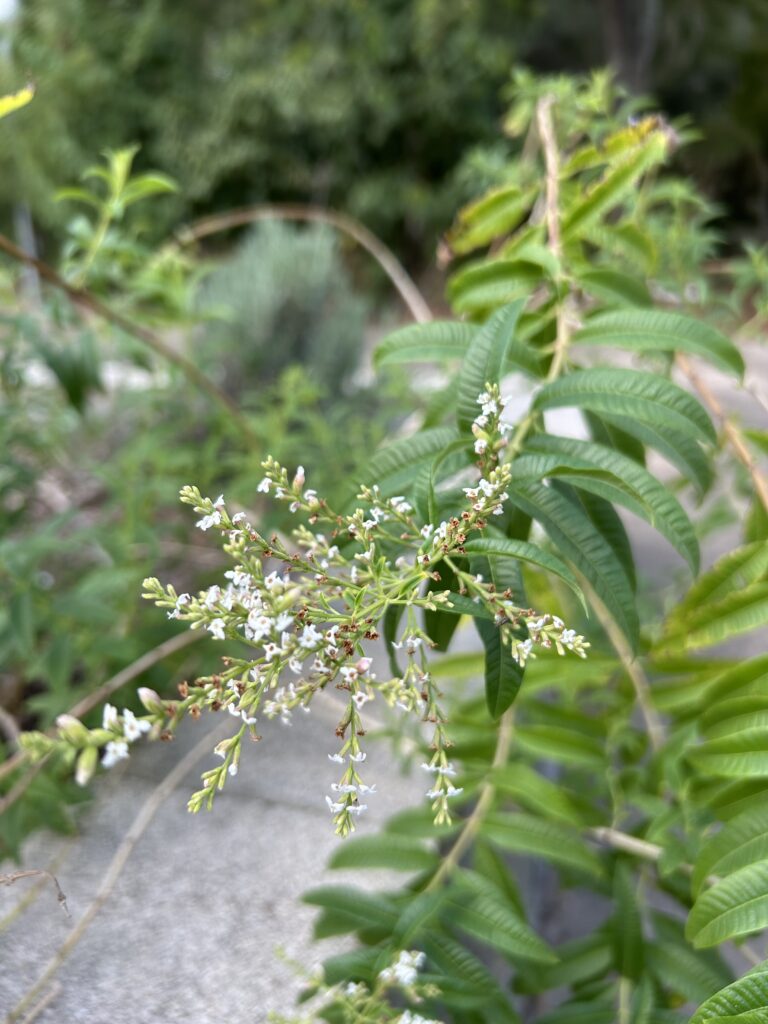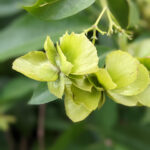Lemon Verbena, Hierba Luisa, Limonete
Botanical Family : Verbenaceae
Native to : South America
Researched by : Wendy Matthews


Botanical Family:
Verbenaceae
Verbenas and lantanas are also in this family. There are 41 species of Aloysia. They are native to the Americas, and many are aromatic. Aloysia virgata, “Almond Bush or Almond Verbena,” is a large deciduous shrub with scented flowers in spring through fall. It grows well here, and some are planted near the stone steps leading from Menke House to the Cloister Garden.
Other common names include :
Cedrón, cidron, citró, limonete, erva-luísa, falsa-erva-cidreira, salva-limão, Lúcia-lima or cidrão.
Cultivation:
Lemon verbena is a woody subshrub with fragrant leaves. It is native to South America, where it can reach 20 feet! It grows best in full sun or with afternoon shade in well-drained soil. It is reliably hardy in zones 9-11, and there it can be grown in the ground, where it may reach 6-8 feet. It can be root hardy (will freeze to the ground in winter) in zone 8 provided it has good drainage, and here it will reach 2-4 feet in a season.
Lemon verbena also grows well in terracotta pots, which can be overwintered indoors, although it may lose its leaves. Be sure to water sparingly in winter, or you will rot the roots.
Propagation is by softwood cuttings during spring and summer. In Southern Herb Growing, Hill/Barclay say, “ It cannot be neatened up much by pruning, but who cares?”
Pests : Aphids, whiteflies, and mealybugs, will sometimes affect lemon verbena. These can be blasted off with water and usually don’t cause significant damage.
Blooms : Lemon verbena produces small white to pale lilac flowers from summer to fall.
Environmental: It is attractive to pollinators, including bees and butterflies. It is currently invasive in Cuba and South Africa.
This plant has gained the Royal Horticultural Society’s Award of Garden Merit.
Folklore & Traditional Uses:
History :
Aloysia was named for Maria Luisa Teresa de Parma (1751-1819), who was the wife of the Spanish king Charles IV. A common name for this plant is Hierba Luisa. It began to be cultivated in Europe in the 18th century and was used for fragrance and for the ‘vapors’ in Victorian times.
First reports of the use of this species date from the 17th century, as it was widely used by the Inca culture as a digestive, antispasmodic, and for bronchitis and heart problems.
Traditional usage :
In many countries of South America, infusions are made from dried or fresh leaves. It is consumed as a tea-like infusion or added to yerba mate (known as chimarrão or cimarrón, a traditional South American caffeine-rich infused drink made of the leaves of Ilex paraguariensis). It is also used as a liquor flavoring and as an ingredient of a soft drink called “Inka Kola,” which is popularly consumed in Peru.
The plant is used for the management of insomnia and anxiety in Latin American countries. In Mexican traditional medicine, the plant is used for stomach disorders, sadness, and nervousness. It is used as a tincture or essential oil as a bactericide and for dermal disorders. In Brazil, the tea is consumed for many purposes, such as cold and fever, influenza, nerve problems, and acne, and as an insecticide, bactericide, tonic, antispasmodic, carminative, and stimulant.
Modern & Medicinal Uses:

The dried leaves will retain their lemon aroma for many years and are used to make an essential oil used in perfumery. The monoterpenes neral and geranial, which are collectively known as citral, are the most abundant constituents in lemon verbena essential oil. Citral is also found in lemongrass oil.
Herbalists in the US currently use it for digestive problems and insomnia, and research suggests it may possess anti-inflammatory and antioxidant properties.
The German company Vital Solutions GmbH markets the product Recoverben®, which is a lemon verbena extract. Their literature states that it is “proven to protect from muscle damage in intense workout, short turn recovery and support muscle strength.”
Toxicity Concerns :
Although lemon verbena has been used for centuries, its toxicity has not been thoroughly investigated. Caution is advised in patients with underlying diseases or with the elderly, children, pregnant women, and nursing mothers. Lemon verbena, similar to several other medicinal plants, has phytochemicals that may be substrates for drug-metabolizing enzymes, so use with conventional drugs in patients with underlying disorders might risk herb-drug interaction.
However, lemon verbena is a GRAS (generally regarded as a safe) plant in the US.
Recipes:
Velvety Lemon Verbena Flan
From Austin-based cookbook author and friend of Festival Hill Gardens
Lucinda Huston’s The Herb Garden Cookbook
This heavenly golden custard is simply exquisite adorned with fragrant sprigs of lemon verbena and delicate flowers.
4 cups half-and-half
1 cup lemony herbs (lemon verbena and/or lemon balm), tightly packed
4 teaspoons lemon zest
2 cups white sugar
7 eggs plus 2 egg yolks
1 pinch salt
¼ teaspoon mace
½ teaspoon vanilla
Optional garnishes: fresh lemon slices, brandy, fresh lemon verbena sprigs (with flowers, when in season)
Scald the half-and-half. Gently wring the herbs to release their flavor; add them to the scalded milk with 2 teaspoons of the lemon zest, pressing down gently with a wooden spoon. Let sit at least 30 minutes.
Carmelize 1 cup sugar by heating it in a small pan over medium heat. Swirl it gently and constantly, until sugar liquefies and turns golden, being careful not to let it burn. Immediately pour caramel into a 1½ -quart baking dish, or into 12-14 small ramekins, working quickly, swirling it around the sides. Set aside.
Preheat oven to 325 degrees, Lightly beat eggs and extra yolks. Mix in the remaining cup of sugar and 2 teaspoons lemon zest. Meanwhile, slowly add the half-and-half mixture to the egg mixture, mixing gently. Add salt, mace, and vanilla. Pour into caramel-coated baking dish or ramekins.
Place baking dish (or ramekins) in a larger pan and carefully pour about an inch of hot water into the larger pan (this is sometimes called a bain marie). Bake for about 1 hour or until a knife inserted in center comes out clean. (Bake individual flans for approximately 25 minutes.)
To serve, gently run knife around edge of flan. Set dish in a pan of hot water for 30 seconds, then carefully invert onto a platter with a slightly curved lip, to ensure that the caramel does not run over. Garnish with lemon slices, and flambé with brandy or dark rum.
NOTE: To flambé, barely heat 6 tablespoons of brandy or dark rum. Pour over the flan and ignite for a beautiful spectacle!
Lovely Lemon Verbena Poundcake
From Lucinda Huston’s The Herb Garden Cookbook
Sour cream poundcake, a family favorite, is even more delicious when accompanied by a tart lemon verbena-brandy glaze. Line the bottom of a baking pan with fresh sprigs of lemon verbena before adding the batter (when the cake is inverted, the leaves will bake in a wreath-like pattern on top). Serve on a platter wreathed with fresh lemon verbena sprigs, fresh strawberry or peach slices, and Johnny jump-ups. Pass the warm glaze in a small pitcher.
Butter and flour to prepare a 10-inch tube pan
3 6” fresh, tender lemon verbena sprigs (optional)
1 cup unsalted butter, slightly softened
2 ¾ cups sugar
6 eggs
¼ teaspoon almond extract
½ teaspoon lemon extract
1 teaspoon vanilla
3 cups white flour
¼ teaspoon salt
¼ teaspoon baking soda
1 cup sour cream
2-3 teaspoons lemon zest
LEMON VERBENA GLAZE
1/4 stick butter
3 tablespoons honey
4 tablespoons fresh lemon juice
½ teaspoon lemon zest
2 tablespoons brandy or dark rum
1 tablespoon finely chopped lemon verbena
Preheat oven to 300 degrees. Butter and lightly flour a 10-inch tube pan, and place lemon verbena sprigs to cover the bottom of the pan with the underside of the leaves facing up. In a large bowl with an electric mixer, cream the butter with the sugar until light and fluffy. Add the eggs, one at a time, and beat well, incorporating the almond, lemon, and vanilla flavorings.
Sift the flour, salt, and soda 3 times. Add alternately with the sour cream to the butter/sugar mixture, stirring constantly. Add lemon zest last.
Spoon batter into prepared pan, taking care to flatten the lemon verbena leaves. Bake at 300 degrees for 1½ hours, or until a wooden pick inserted into middle of cake tests dry.
Loosen edges with a knife, and let stand for 15 minutes in the pan; then invert on a wire rack to cool. Serves 16-18.
To make the glaze, melt the butter in a small saucepan. Add the honey, lemon juice, and zest, then bring to a gentle boil. Remove from heat. Add the brandy and chopped lemon verbena. If made earlier in the day, reheat before serving and drizzle over slices of the cake. Makes 1⁄2 cup glaze.
NOTE: Lemon balm and lemon thyme may be substituted for lemon verbena in the glaze. You also may substitute rose geranium or lemon geranium leaves for the lemon verbena sprigs in the cakepan; if you do, use 1-2 teaspoons rosewater in place of the almond extract. This cake gets better with age.
Sweet Kathryn
From Southern Herb Growing-Madeline Hill, Gwen Barclay, Jean Hardy
This light, summery dessert features lemon verbena. It was a favorite of daughter and granddaughter Kathryn Barclay, who never knew it contained avocado until the day she decided to make it herself.
1 small can crushed pineapple (6 ½ ounces)
1 tablespoon unflavored gelatin
½ cup sugar, divided
½ teaspoon salt
¼ cup cold water
¼ cup fresh lime juice
3 eggs, separated
2 tablespoons chopped lemon verbena
1 large avocado, mashed
½ cup heavy cream, whipped
Lemon verbena sprig for garnish
Drain pineapple, reserving liquid. Combine until smooth the pineapple juice, gelatin, ¼ cup sugar, salt, water, lime juice, egg yolks and lemon verbena. Cook over low heat, stirring constantly until thickened to custard consistency.
Remove from heat and cool slightly. Stir in crushed pineapple and mashed avocado. Cool to room temperature.
Whip egg whites with remaining ¼ cup sugar till stiff but not dry. Fold gently into custard mixture. Fold in whipped cream, and spoon into dessert dishes or soufflé dish. Chill completely. Serve garnished with sprig of lemon verbena.
More Culinary Uses of Lemon Verbena
- Salad dressings, vinegars, marinades, & pestos
- Pairs well with fruit dishes
- Grind leaves with sugar and use in baked goods
- Steep with milk and use for ice cream, whipped cream, or custard
- Use in sorbet or simple syrup
- Add to white wine, sangria, gin and tonic, or other cocktails
- Make lemon verbena jelly
- And of course, in tea!
Other Uses
Use in homemade soap or candles
Make a sachet or potpourri
Brew an infusion and add it to bathwater
References:
Hill, Madalene, and Gwen Barclay. Southern Herb Growing. Fredericksburg, TX: Shearer Publishing, 1 Apr. 1997.
Hutson, Lucinda. The Herb Garden Cookbook. Austin, TX: Texas Monthly Press, Inc., 1987.
“Aloysia Citriodora (Lemon Beebrush, Lemon Verbena) | North Carolina Extension Gardener Plant Toolbox.”, Ncsu.edu, 2025, https://plants.ces.ncsu.edu/plants/aloysia-citriodora/. Accessed on: 6/2/2025.
Wikipedia Contributors, “Aloysia.” Wikipedia, Wikimedia Foundation, 23 May 2024, https://en.wikipedia.org/wiki/Aloysia. Accessed on: 6/2/2025.
“Aloysia Citriodora Lemon Verbena, Lemon Beebrush PFAF Plant Database.” Pfaf.org, https://pfaf.org/user/Plant.aspx?LatinName=Aloysia+citriodora. 20 Sept 2011, Accessed on: 6/2/2025.
Rojas-Sandoval, J. “Aloysia Citrodora (Lemon Verbena).” CABI Compendium, vol. CABI Compendium, 7 Jan. 2022, https://doi.org/10.1079/cabicompendium.112152. Accessed on: 6/2/2025.
Verena, “Lemon Verbena: Planting & Propagation – Plantura.” Plantura, 8 Dec. 2021, https://plantura.garden/uk/herbs/lemon-verbena/lemon-verbena-overview. Accessed on: 6/2/2025.
Bahramsoltani, Roodabeh, et al. “Aloysia Citrodora Paláu (Lemon Verbena): A Review of Phytochemistry and Pharmacology.” Journal of Ethnopharmacology, vol. 222, Aug. 2018, pp. 34–51, https://doi.org/10.1016/j.jep.2018.04.021. Accessed 6/2/2025.
Return to South America
Return to Pharmacy Garden









